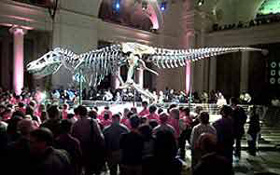Tyrannosaurus Sue

The prehistoric giant stands again
 After 65 million years, Sue is back on her feet. |
SUE IS A SENSATION. It's not just that she's 42 feet long and 65 million years old. She's the world's most complete, best preserved, and largest Tyrannosaurus rex skeleton. More than 10,000 visitors went to her May 17, 2000, debut at Chicago's Field Museum of Natural History.
Many brought their cameras—and a few brought violins. The Chicago Chamber Musicians performed a new piece, written especially for the opening, caled “Tyrannosaurus Sue: A Cretaceous Concerto.” (T. rex lived during the Cretaceous period, not the Jurassic period, as many believe.)
Rest in Pieces
Sue's Stats
|
Amazingly, more than 200 of Sue's bones were preserved. The skeleton includes the most complete T. rex tail ever found, as well as one of only two T. rex arms ever found. Sue's skull contains the longest (and scariest) T. rex tooth yet known—it's a foot long.
One amazing discovery in Sue's skeleton is that she has a wishbone, or furcula, such as you would find in most bird skeletons. This is the first wishbone found on a T. rex. It supports the theory that birds evolved from dinosaurs, either directly or from a common ancestor.
Even though Sue's bones are more than 65 million years old, they are so well-preserved that you can see marks where muscles and tendons once lay.
Slow, But Deadly
Studies of Sue's footbones have indicated that T. rex probably walked at about 6 mph and ran at not more than 15 mph, much slower than previously thought.
The lead researcher on Sue says that the way T. rex the moved in the movie Jurassic Park was probably very accurate. Most likely T. rex bent over so that its huge tail did not touch the ground, and walked on its toes—T. rex is digitigrade, meaning it walks on its toes like a cat. (People are plantigrade, meaning we walk flat-footed.)
But the movie was wrong that T. rex would have to see its prey move in order to find it—from studying Sue, researchers have determined that T. rex had an excellent sense of smell. Sue's skull reveals that in a T. rex brain the smelling part (the olfactory nodes) was much larger than the thinking part (the cerebrum).
Sue or Sir?
Tyrannosaurus Sue was named for Sue Hendrickson, the fossil hunter who found the skeleton in 1990. But although the skeleton is generally referred to as a “she,” no one really knows whether Tyrannosaurus Sue was male or female. The skeleton's very large size could suggest that the dinosaur was female, because among birds of prey—T. rex's closest ancestors—females are generally larger than males.
Senior Sue
Throughout her life Sue suffered some hard knocks, including broken ribs and an injured arm. Although scientists do not know exactly what illnesses dinosaurs had, it looks as though Sue was affected by an age-related disease much like arthritis. “Here is a very, very old dinosaur that just got sick and died after a long, active life,” says John Flynn, a Field Museum paleontologist.
Just how old was she? Scientists don't know for sure how long a T. rex might have lived. Says Flynn, “We know turtles and crocodiles can live to 150 years, and they are cold-blooded. We know some birds, which are warm-blooded, can live for many decades. My guess is that dinosaurs could live for decades, some 100 years or more.”
Queen of the Dinosaurs
For many of the researchers who have gotten to know Sue, the discovery of the massive T. rex was the event of a lifetime. “It's truly a dream fossil,” says Tony Wentz, who worked to dig Sue out of the ground and helped prepare her skeleton for the exhibit. “It's the best of the best, the biggest, the most well-preserved. Everything you could ever want in digging a dinosaur was in Sue.”
Tyrannosaurus rex Classification
| Kingdom | Animalia | animal |
| Phylum | Chordata | has a nerve cord ending at a brain |
| Class | Archosauria | has hollow teeth, special ankles, pointy head |
| Order | Saurischia | “lizard-hipped” |
| Suborder | Theropoda | walks on two feet, eats meat |
| Family | Tyrannosauroidea | a predator with tiny forelimbs (“arms”) |
| Genus | Tyrannosaurus | “tyrant lizard” |
| Species | rex | “king” |
